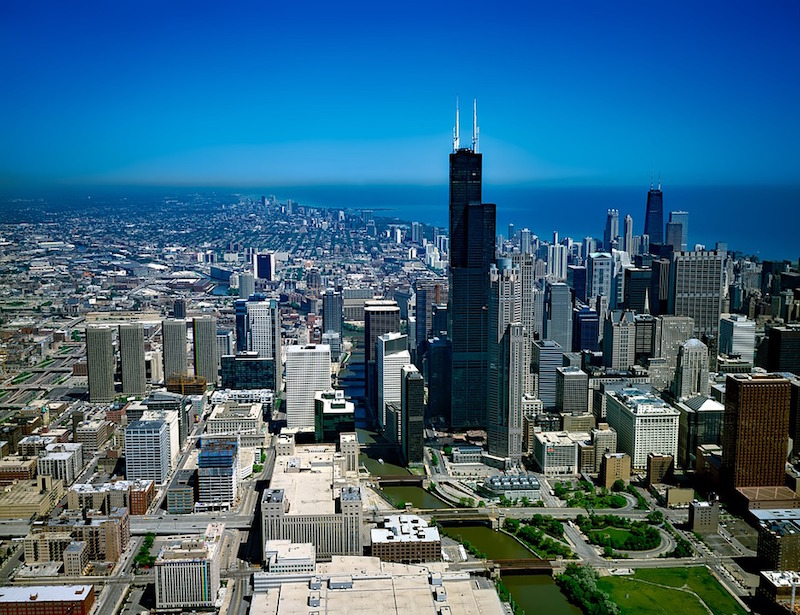The taller the building, the more prestigious it appears. At least, that’s how the thinking goes. Recently, cities around the world are beginning to use tall buildings to show off their wealth and prosperity in the same way professional athletes use garages filled with Ferraris, Aston Martins, and Lamborghinis.
Sure, tall buildings provide a way of maximizing space in crowded cities, but a report from the Council on Tall Buildings and Urban Habitat (CTBUH) points to the fact that many supertalls around the world have hundreds of feet of non-occupiable space. This “vanity height” as it is referred to, exists purely as a design element and to make the building taller.
In fact, if you eliminate vanity height, 44 of the world’s 72 supertalls (the number at the time of the report using July 2013 data) would measure less than 300 meters, losing their supertall status. The tallest of these building’s is Guangzhou’s 390-meter CITIC Plaza. Seeing these tall buildings only to realize so much of it is purely for aesthetics is like buying a large bag of chips only to discover a third of it is filled with air.
In terms of sheer height, the Burj Khalifa is the most egregious vanity height offender. 244 meters at the top of the world’s tallest tower is non-occupiable, that’s a whopping 800 feet. In other terms, if the Burj Khalifa’s vanity height were a building in its own right, it would be Europe’s 11th-tallest building.
In terms of percentage, another Dubai building is the worst offender. 39% of the Burj Al Arab’s height is non-occupiable space. However, at the opposite end of the spectrum, Dubai is also home to The Index, which has a vanity height of only four meters, or 1% of the buildings overall height.
New York has three of the worst offenders with the Bank of America Tower (131 meters, 36%), New York Times Tower (99 meters, 31%), and One World Trade Center (134 meters, 25%). The Empire State Building, however, plays the role of New York’s Index, as it loses just 1% of its height to non-occupiable space.
Measuring building height has been a fairly subjective practice over the years. Spires are counted toward height (which some view as counterproductive and rewarding vanity height) while antennae are not. In 1998, the then Sears Tower lost its title of tallest building in the world to Petronas Towers despite being almost 250 feet taller when its antennae were included and also having a higher occupiable top floor. The Petronas Towers’ spires, which are included in the building’s height, reach 1,483 feet in the air while the Sears Tower without its antennae, which are not included in its overall height, only reaches 1,454 feet. With the antennae the Sears Tower is 1,707 feet.
The now Willis Tower lost out again to vanity height in determining the tallest building in the United States. The Willis Tower’s roof is 442.1 meters high while One World Trade Center’s roof is 417 meters high. Again, however, One World Trade Center’s spire counts towards its height, bringing it up to 1,776 feet and giving it the distinction of being the tallest building in the U.S.
So what does all of this mean? Well, not much, except the list of the tallest buildings in the world would be shuffled around a bit if spires, masts, and antennae were counted toward a building’s overall height or, conversely, if buildings were just measured to their top floors.
But there really isn’t a simple solution: completely occupiable or not, the Burj Khalifa is still the tallest structure ever created (to this point. Jeddah Tower will take the title when it is completed, most likely with quite a bit of non-occupiable space of its own). But if you allow spires, antennae, or other non-occupiable components to count, then some architects and developers could add comically large elements to their structures just to get the accolade of tallest structure in the world.
Regardless, whichever way you measure it, architects are continuing to push the boundaries of what is possible in terms of building height as more tall buildings than ever are popping up in cities around the world.
Related Stories
| Feb 14, 2012
Thornton Tomasetti names Al Hashimi vice president for its Middle East Operations
Al Hashimi is joining the company to help expand Thornton Tomasetti’s business in the region and support clients locally.
| Feb 8, 2012
World’s tallest solar PV-installation
The solar array is at the elevation of 737 feet, making the building the tallest in the world with a solar PV-installation on its roof.
| Jan 30, 2012
Hollister Construction Services to renovate 30 Montgomery Street in Jersey City, N.J.
Owner Onyx Equities hires firm to oversee comprehensive upgrades of office building.
| Jan 16, 2012
Mid-Continent Tower wins 25 Year Award from AIA Eastern Oklahoma
Designed by Dewberry, iconic tower defines Tulsa’s skyline.
| Jan 4, 2012
Shawmut Design & Construction awarded dorm renovations at Brown University
Construction is scheduled to begin in June 2012, and will be completed by December 2012.
| Jan 3, 2012
Rental Renaissance, The Rebirth of the Apartment Market
Across much of the U.S., apartment rents are rising, vacancy rates are falling. In just about every major urban area, new multifamily rental projects and major renovations are coming online. It may be too soon to pronounce the rental market fully recovered, but the trend is promising.
| Dec 27, 2011
Ground broken for adaptive reuse project
Located on the Garden State Parkway, the master-planned project initially includes the conversion of a 114-year-old, 365,000-square-foot, six-story warehouse building into 361 loft-style apartments, and the creation of a three-level parking facility.
| Dec 21, 2011
BBI key to Philly high-rise renovation
The 200,000 sf building was recently outfitted with a new HVAC system and a state-of-the-art window retrofitting system.
| Dec 19, 2011
Chicago’s Aqua Tower wins international design award
Aqua was named both regional and international winner of the International Property Award as Best Residential High-Rise Development.
| Dec 14, 2011
Belfer Research Building tops out in New York
Hundreds of construction trades people celebrate reaching the top of concrete structure for facility that will accelerate treatments and cures at world-renowned institution.

















